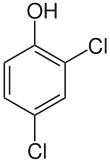| |||
| Names | |||
|---|---|---|---|
| Preferred IUPAC name 2,4-Dichlorophenol | |||
| Identifiers | |||
| CAS Number | |||
| 3D model (JSmol) | |||
| Beilstein Reference | 742467 | ||
| ChEBI | |||
| ChEMBL | |||
| ChemSpider | |||
| ECHA InfoCard | 100.004.027 | ||
| EC Number |
| ||
| Gmelin Reference | 261170 | ||
| KEGG | |||
| PubChem CID | |||
| RTECS number |
| ||
| UNII | |||
| UN number | 2020 | ||
| CompTox Dashboard (EPA) | |||
InChI
| |||
SMILES
| |||
| Properties | |||
| Chemical formula | C6H4Cl2O | ||
| Molar mass | 163.00 g·mol | ||
| Appearance | White solid | ||
| Odor | Phenolic | ||
| Density | 1.38 g/cm | ||
| Melting point | 43.2 °C (109.8 °F; 316.3 K) | ||
| Boiling point | 210 °C (410 °F; 483 K) | ||
| Solubility in water | 50 g/L | ||
| Thermochemistry | |||
| Std enthalpy of formation (ΔfH298) |
−226.4 kJ·mol (s) −156.3 kJ·mol (gas) | ||
| Hazards | |||
| GHS labelling: | |||
| Pictograms |    
| ||
| Signal word | Danger | ||
| Hazard statements | H302, H311, H314, H411 | ||
| Precautionary statements | P260, P264, P270, P273, P280, P301+P312, P301+P330+P331, P302+P352, P303+P361+P353, P304+P340, P305+P351+P338, P310, P312, P321, P322, P330, P361, P363, P391, P405, P501 | ||
| NFPA 704 (fire diamond) |
 | ||
| Flash point | 114 °C (237 °F; 387 K) | ||
| Lethal dose or concentration (LD, LC): | |||
| LD50 (median dose) | 47.0 mg/kg (oral in rats) 790.0 mg/kg (Dermal exposure in mammals) | ||
| Safety data sheet (SDS) | External MSDS | ||
| Except where otherwise noted, data are given for materials in their standard state (at 25 °C , 100 kPa).
| |||
2,4-Dichlorophenol (2,4-DCP) is a chlorinated derivative of phenol with the molecular formula Cl2C6H3OH. It is a white solid that is mildly acidic (pKa = 7.9). It is produced on a large scale as a precursor to the herbicide 2,4-dichlorophenoxyacetic acid (2,4-D).
Production and use
2,4-DCP is produced by chlorination of phenol.
Annual worldwide production is estimated at 88 million pounds. It is also a photo-degradation product of the common antibacterial and antifungal agent triclosan along with the dioxin 2,8-dichlorodibenzo-p-dioxin.
Safety
The LD50 is 580 mg/kg (rats, oral). Liquid (molten) 2,4-DCP is readily absorbed through the skin. Solid 2,4-DCP does not readily absorb through skin and has a lower NFPA H=3 rating (versus H=4 for molten 2,4-DCP). This is primarily caused by instantaneous kidney failure, liver failure, and failure of various other organs.
See also
References
- ^ Haynes, p. 3.166
- Haynes, p. 5.12
- Haynes, p. 16.20
- ^ François Muller, Liliane Caillard (2011). "Chlorophenols". Ullmann's Encyclopedia of Industrial Chemistry. Weinheim: Wiley-VCH. doi:10.1002/14356007.a07_001.pub2. ISBN 978-3-527-30673-2.
- Desmurs J, Ratton S. Chlorophenols. In: Kirk-Othmer Encyclopedia of Chemical Technology, 4th Edition. Kroschwitz JI, Howe-Grant M, eds. New York: John Wiley and Sons, 1993;6:156–168
- Singer H, Muller S, Tixier C, Pillonel L (2002). "Triclosan: occurrence and fate of a widely used biocide in the aquatic environment: field measurements in wastewater treatment plants, surface waters, and lake sediments". Environ Sci Technol. 36 (23): 4998–5004. Bibcode:2002EnST...36.4998S. doi:10.1021/es025750i. PMID 12523412.
- Latch DE, Packer JL, Stender BL, VanOverbeke J, Arnold WA, McNeill K (2005). "Aqueous photochemistry of triclosan: formation of 2,4-dichlorophenol, 2,8-dichlorodibenzo-p-dioxin, and oligomerization products". Environ. Toxicol. Chem. 24 (3): 517–25. doi:10.1897/04-243R.1. PMID 15779749. S2CID 19322739.
- Kintz P, Tracqui A, Mangin P (1992). "Accidental death caused by the absorption of 2,4-dichlorophenol through the skin". Arch. Toxicol. 66 (4): 298–9. doi:10.1007/BF02307178. PMID 1514931. S2CID 23764834.

